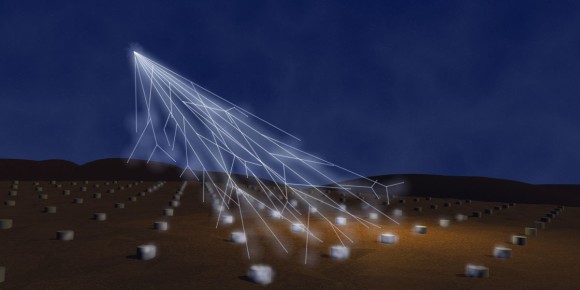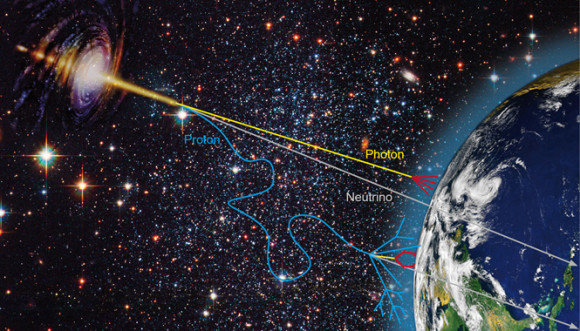The Pierre Auger Collaboration, gathered recently in the AugerPrime Symposium, in Malargüe, Argentina to celebrate 15 years of achievements, and the new International Agreement for the next 10 years. In the symposium, the Observatory’s upcoming upgrade was presented to representatives from all countries participating in the experiment, and scientists from other experiments, like IceCube.
The AugerPrime upgrade will enhance the 1660 existing surface detectors (water tanks sensitive to Cherenkov light generated by the shower products) with new scintillation detectors, so that electromagnetic and muonic shower particles can be separated more efficiently. This in turn, together with smaller area of buried muon detectors, improves the determination of the mass of the primary cosmic rays, otherwise not directly measurable.

Artist’s impression of the extensive air-shower that develops in the atmosphere, when an ultra-high energy cosmic ray hits the top of the atmosphere. The stations on the ground show the configuration of the Auger surface detector.
This is great news for AMON as well! The Auger Observatory is at present the only AMON partner sensitive to photons, neutrinos and hadrons at ultra-high energies (energies exceeding 1018 electron-volts ). As a triggering AMON partner, Auger transmits the arrival direction, and energy of detected cosmic rays to AMON in real-time. What’s more, a near real-time search in the Auger data stream is performed, when another AMON partner issues an alert in the Auger field-of-view.

Schematic view of the intergalactic trajectories of ultra-high energy protons, photons, and neutrinos. Protons do not arrive in temporal coincidence with the other messengers due to being deflected, and delayed by intervening magnetic fields. Image credit: DESY/Zeuthen
A cluster of Auger cosmic rays detected in close temporal and spatial proximity (separated by less than 3º and less than 100 seconds) generates an AMON follow-up alert: it bears the signature of a burst of neutral particles produced in an astrophysical transient. In addition Auger will soon provide AMON with a measure of the “photon-likeness” of each event transmitted to AMON in real-time. This is determined by the muon content of the showers as recorded by the Auger surface detector (photon showers are very muon poor compared to hadronic showers). With the AugerPrime upgrade photons will be better distinguishable from hadrons, and Auger will be able to provide AMON with a higher confidence photon sample in real-time. This will in turn enhance the capability of AMON to detect Astrophysical transients that produce ultra-high energy particles. This is because the charged cosmic rays detected by Auger get delayed by cosmic magnetic fields, thus they are not expected in coincidence with other electromagnetic, or neutrino signals from their source.
In the near future Auger will also provide AMON with ultra-high energy neutrino shower arrival directions and energies in real-time. Ultra-high energy neutrino induced extensive air-showers are easily distinguishable from hadron and photon showers with the Auger surface detector, which has published the world’s tightest limits to the flux of of ultra-high energy neutrinos to date. Unfortunately, the elusive neutrinos have a much lower interaction cross-section than other cosmic messengers making them much rarer to detect.
For more details, you can take a look at the slides presented in the recent AMON workshop.


No comments yet.